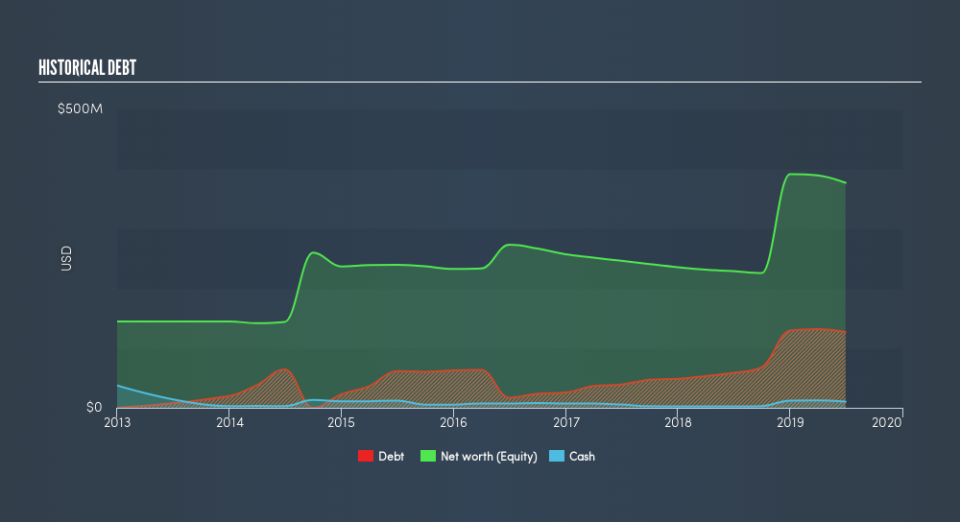These 4 Measures Indicate That Independence Contract Drilling (NYSE:ICD) Is Using Debt In A Risky Way

The external fund manager backed by Berkshire Hathaway's Charlie Munger, Li Lu, makes no bones about it when he says 'The biggest investment risk is not the volatility of prices, but whether you will suffer a permanent loss of capital.' So it seems the smart money knows that debt - which is usually involved in bankruptcies - is a very important factor, when you assess how risky a company is. Importantly, Independence Contract Drilling, Inc. (NYSE:ICD) does carry debt. But should shareholders be worried about its use of debt?
When Is Debt A Problem?
Generally speaking, debt only becomes a real problem when a company can't easily pay it off, either by raising capital or with its own cash flow. If things get really bad, the lenders can take control of the business. However, a more frequent (but still costly) occurrence is where a company must issue shares at bargain-basement prices, permanently diluting shareholders, just to shore up its balance sheet. Having said that, the most common situation is where a company manages its debt reasonably well - and to its own advantage. The first step when considering a company's debt levels is to consider its cash and debt together.
Check out our latest analysis for Independence Contract Drilling
What Is Independence Contract Drilling's Debt?
As you can see below, at the end of June 2019, Independence Contract Drilling had US$127.1m of debt, up from US$60.0m a year ago. Click the image for more detail. However, it does have US$10.3m in cash offsetting this, leading to net debt of about US$116.9m.
A Look At Independence Contract Drilling's Liabilities
Zooming in on the latest balance sheet data, we can see that Independence Contract Drilling had liabilities of US$50.8m due within 12 months and liabilities of US$130.9m due beyond that. Offsetting these obligations, it had cash of US$10.3m as well as receivables valued at US$35.9m due within 12 months. So its liabilities outweigh the sum of its cash and (near-term) receivables by US$135.5m.
The deficiency here weighs heavily on the US$84.8m company itself, as if a child were struggling under the weight of an enormous back-pack full of books, his sports gear, and a trumpet. So we'd watch its balance sheet closely, without a doubt At the end of the day, Independence Contract Drilling would probably need a major re-capitalization if its creditors were to demand repayment.
In order to size up a company's debt relative to its earnings, we calculate its net debt divided by its earnings before interest, tax, depreciation, and amortization (EBITDA) and its earnings before interest and tax (EBIT) divided by its interest expense (its interest cover). This way, we consider both the absolute quantum of the debt, as well as the interest rates paid on it.
Even though Independence Contract Drilling's debt is only 2.2, its interest cover is really very low at 0.96. In large part that's it has so much depreciation and amortisation. While companies often boast that these charges are non-cash, most such businesses will therefore require ongoing investment (that is not expensed.) Either way there's no doubt the stock is using meaningful leverage. We also note that Independence Contract Drilling improved its EBIT from a last year's loss to a positive US$12m. There's no doubt that we learn most about debt from the balance sheet. But it is future earnings, more than anything, that will determine Independence Contract Drilling's ability to maintain a healthy balance sheet going forward. So if you want to see what the professionals think, you might find this free report on analyst profit forecasts to be interesting.
Finally, while the tax-man may adore accounting profits, lenders only accept cold hard cash. So it is important to check how much of its earnings before interest and tax (EBIT) converts to actual free cash flow. During the last year, Independence Contract Drilling burned a lot of cash. While investors are no doubt expecting a reversal of that situation in due course, it clearly does mean its use of debt is more risky.
Our View
On the face of it, Independence Contract Drilling's interest cover left us tentative about the stock, and its conversion of EBIT to free cash flow was no more enticing than the one empty restaurant on the busiest night of the year. But at least its EBIT growth rate is not so bad. Taking into account all the aforementioned factors, it looks like Independence Contract Drilling has too much debt. That sort of riskiness is ok for some, but it certainly doesn't float our boat. Given our concerns about Independence Contract Drilling's debt levels, it seems only prudent to check if insiders have been ditching the stock.
If you're interested in investing in businesses that can grow profits without the burden of debt, then check out this free list of growing businesses that have net cash on the balance sheet.
We aim to bring you long-term focused research analysis driven by fundamental data. Note that our analysis may not factor in the latest price-sensitive company announcements or qualitative material.
If you spot an error that warrants correction, please contact the editor at editorial-team@simplywallst.com. This article by Simply Wall St is general in nature. It does not constitute a recommendation to buy or sell any stock, and does not take account of your objectives, or your financial situation. Simply Wall St has no position in the stocks mentioned. Thank you for reading.

